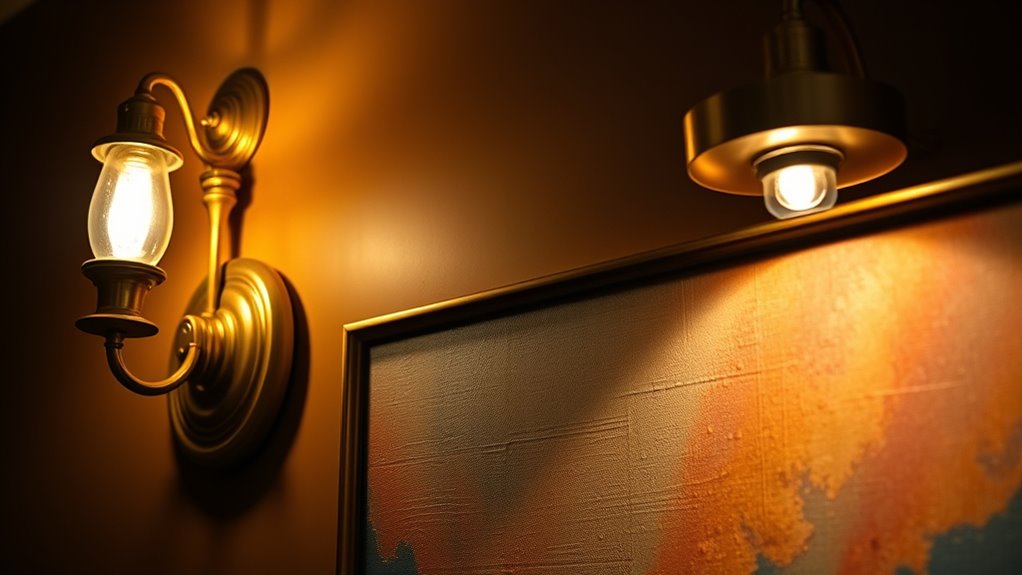For lighting your wall art effectively, choose fixtures like sconces and picture lights to enhance colors and details while reducing glare. Look for high CRI (90+) lights to guarantee accurate color rendering, making your artwork look vibrant and true to life. Proper placement and angles are essential to avoid reflections and shadows. If you’re curious about optimizing your setup and selecting the best options, keep exploring for expert tips and insights.
Key Takeaways
- Sconces provide ambient or accent lighting, enhancing wall art visibility and creating inviting atmospheres.
- Picture lights are designed for targeted illumination, highlighting artwork’s colors and details while minimizing glare.
- High CRI (90+) lighting ensures accurate color rendering, making artwork appear vibrant and true to life.
- Proper placement and angle of fixtures prevent reflections, shadows, and distortions, optimizing artwork visibility.
- Full-spectrum and adjustable lighting options help personalize illumination, enhancing the visual impact of wall art.
Types of Wall Lighting for Art Displays
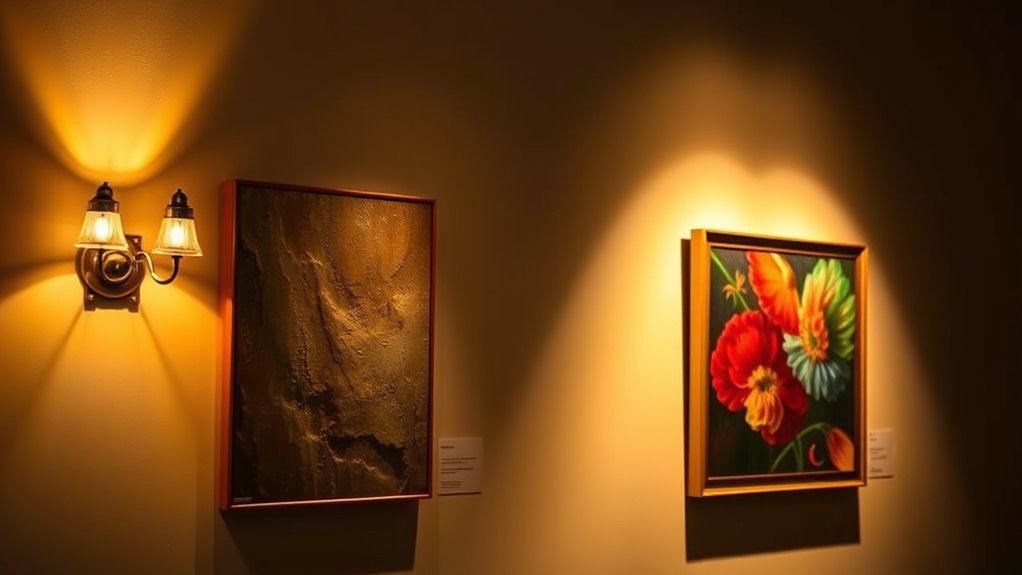
When choosing wall lighting for art displays, you have several options to highlight your pieces effectively. LED strip lighting offers a sleek, flexible solution that can be concealed behind frames or molding, providing a subtle glow that enhances colors and details. Track lighting is another versatile choice, allowing you to position adjustable fixtures precisely where you want the most emphasis. It’s perfect for spotlighting individual artworks or creating a layered lighting effect across a gallery wall. Both options provide focused illumination that draws attention without overwhelming the art. Consider your space’s layout and the type of art you display to select the best lighting. Additionally, choosing lighting with a high CRI ensures accurate color rendering, so your artwork appears true to life. Using professional-grade lighting can also help prevent damage caused by UV rays or heat. Implementing proper lighting placement is essential for achieving optimal visual impact and protecting your art over time. Proper wall lighting can also add to the overall ambiance of your space, making your art stand out beautifully. These options help you showcase your collection with clarity and style while maintaining a clean, modern aesthetic.
Benefits of Using Sconces and Picture Lights
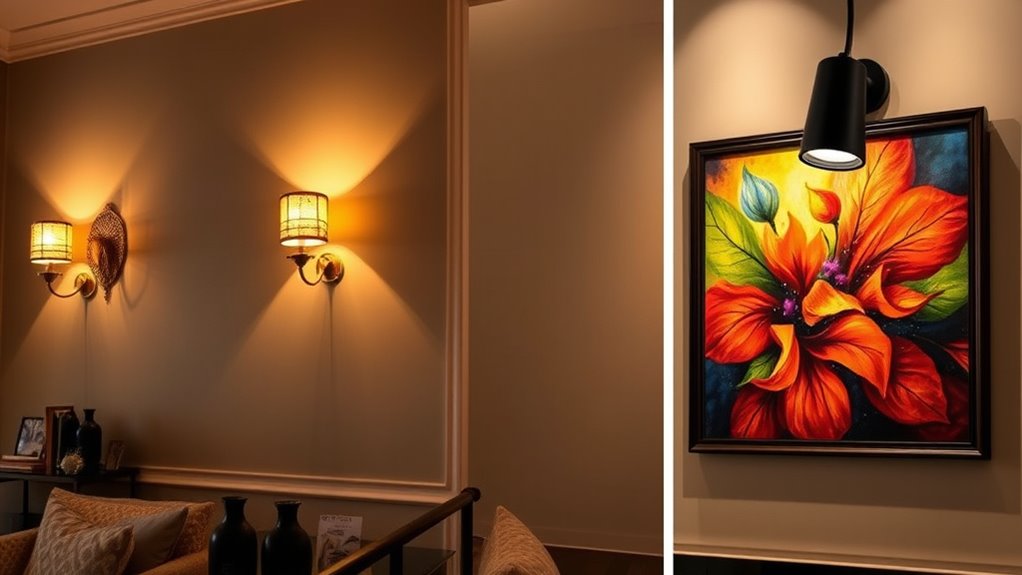
Sconces and picture lights offer several advantages for illuminating wall art effectively. They create an ambient glow that highlights your artwork without overpowering the space, adding warmth and inviting atmosphere. Unlike harsh overhead lighting, these fixtures direct light precisely where it’s needed, reducing glare and shadows. This targeted illumination enhances the visual impact of your art, making colors appear richer and details more vivid. Additionally, sconces and picture lights can improve space perception by drawing attention to specific areas, making your room feel larger and more curated. Their design options also add style, complementing your decor while serving a functional purpose. Proper lighting placement ensures your artwork is showcased in the best possible way, further elevating your display. Overall, these fixtures help you achieve a balanced, elegant display that enhances your wall art and elevates your entire space. Incorporating lighting design principles can further optimize how your art is appreciated and appreciated in your home.
Understanding Color Rendering Index and Its Impact on Art
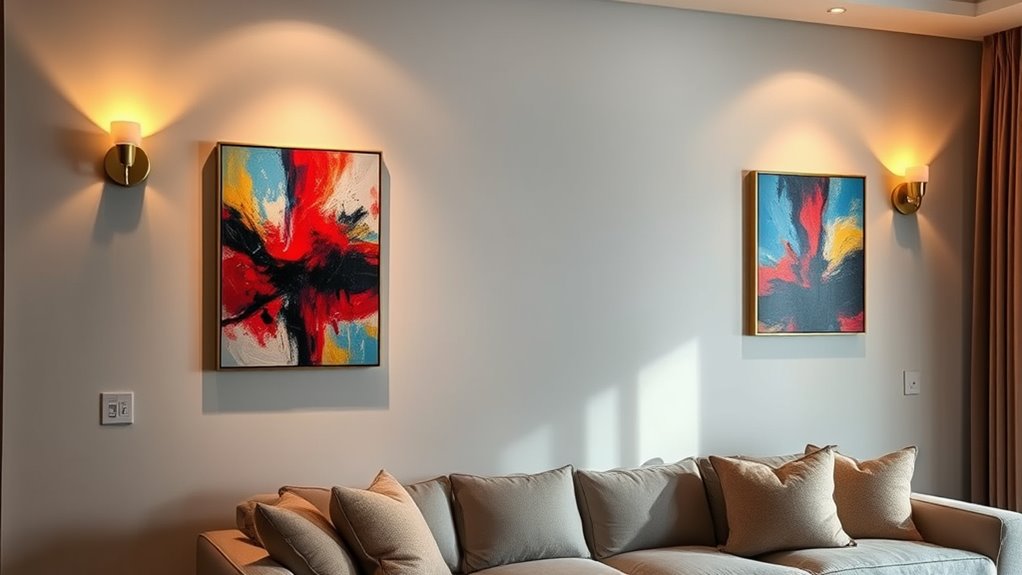
Understanding the Color Rendering Index (CRI) is essential because it measures how accurately a light source reveals the true colors of your wall art. A high CRI indicates better color accuracy, making your artwork appear vibrant and true to life. The light spectrum plays a vital role here; full-spectrum lights mimic natural daylight, enhancing detail and subtle hues. Low-CRI lights can distort colors, causing reds to appear dull or greens to look off, which diminishes the visual impact of your art. When selecting lighting, prioritize sources with a CRI of 90 or above for superior color fidelity. This guarantees your wall art is displayed in its best light, with colors that are true, lively, and engaging. Color accuracy is crucial for ensuring your art’s visual impact remains uncompromised. Accurate lighting transforms how your art is perceived and appreciated, and understanding CRI values helps you choose the most suitable lighting for your display. Additionally, choosing lighting with appropriate color temperature can further enhance the visual appeal of your artwork by complementing its tones.
Tips for Proper Placement and Angle of Lights
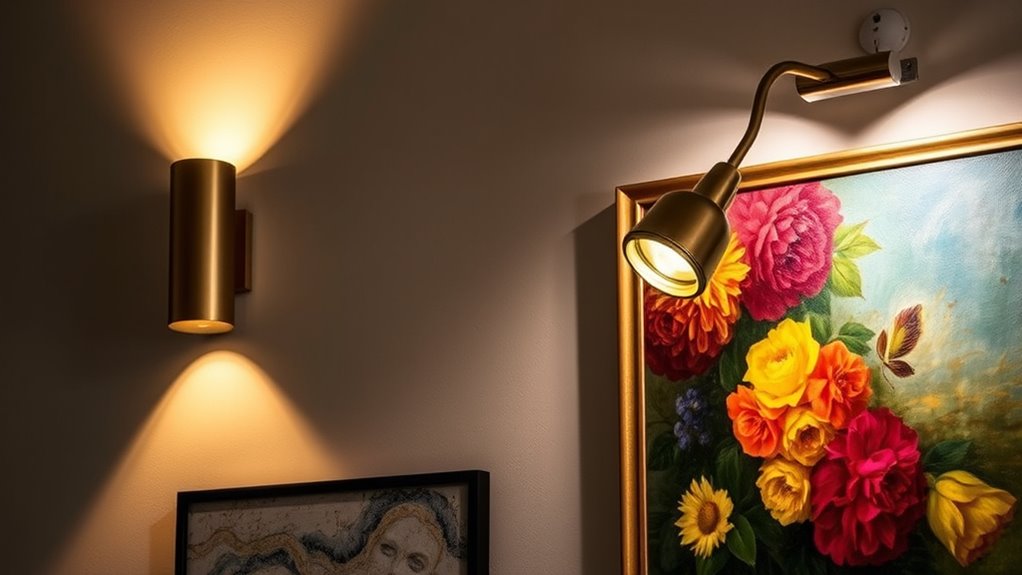
Proper placement and angling of your lights are essential for highlighting wall art effectively. To achieve ideal results, consider these tips:
- Use recessed lighting to create focused, unobtrusive illumination that highlights artwork without glare. Incorporating lighting fixtures that are adjustable can provide more control over the direction and intensity of light. Additionally, choosing fixtures with high CRI ratings ensures accurate color rendering of your art pieces.
- Position track lighting fixtures about 4-12 inches from the wall, angling them downward at 30-45 degrees for even coverage.
- Avoid placing lights directly above or below the art to prevent unwanted shadows and distortion.
- Adjust the height and angle so the light hits the artwork at eye level or slightly above, enhancing depth and color vibrancy.
- Regularly check for lighting maintenance to ensure your fixtures are functioning optimally and illuminating your wall art effectively. Incorporating appropriate lighting fixtures, such as sconces or picture lights, can further enhance the visual appeal and ensure your art is showcased beautifully.
Choosing the Right Fixtures for Different Artwork Styles
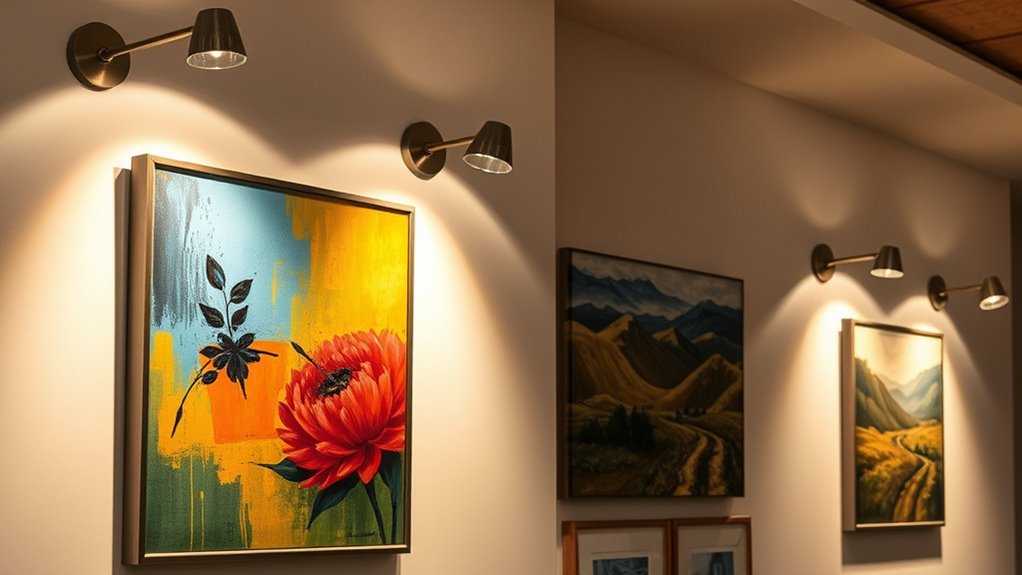
Choosing the right fixtures for different artwork styles requires considering how each piece’s unique qualities interact with lighting. For classic, traditional artwork, opt for picture lights with warm, soft illumination to enhance the artistic style and create a cozy lighting ambiance. Modern or minimalist pieces benefit from sleek, focused sconces that deliver clean, direct light without overpowering the art. Abstract or vibrant artwork might require adjustable fixtures to highlight bold colors and textures, establishing a dynamic lighting ambiance. Consider the artwork’s material—glossy or textured surfaces may need different fixture types to avoid glare. Overall, selecting fixtures that complement the artistic style guarantees the lighting enhances the art’s character while setting the right mood in your space. Attention in creative practice can also be a useful factor to consider when choosing lighting to ensure focus and highlight details effectively. Additionally, understanding the lighting quality and its impact on color rendering can significantly improve how artwork is perceived. Incorporating proper light placement is essential to prevent unwanted shadows or reflections that could detract from the visual impact of the art. Recognizing the importance of CRI helps ensure that colors are displayed accurately under the chosen lighting.
Avoiding Glare and Distortion When Illuminating Wall Art
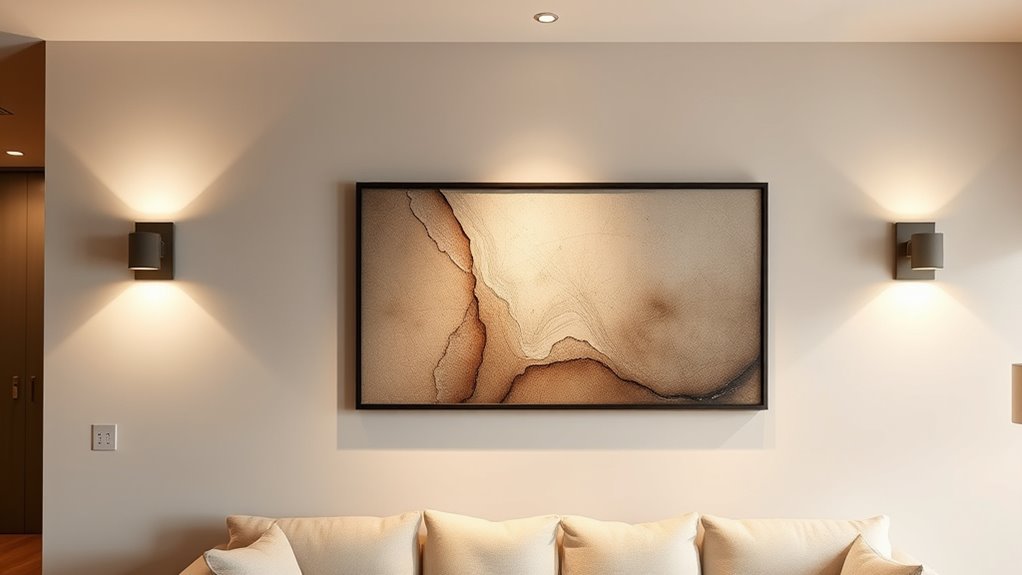
To prevent glare and distortion when illuminating wall art, you need to carefully position your fixtures and select the right type of lighting. First, use fixtures with anti glare coatings to minimize harsh reflections. Second, employ light diffusion techniques, such as frosted bulbs or lampshades, to spread light evenly. Third, angle your lights slightly away from the artwork to avoid direct reflections. Fourth, choose adjustable fixtures to fine-tune the light direction and intensity. These steps help reduce glare, prevent distortion, and enhance the artwork’s true colors and details. Incorporating AI-driven personalization in lighting design can also help customize illumination settings to suit specific wall art and viewing conditions. Proper placement combined with the right fixtures ensures your wall art remains visually appealing without unwanted reflections or distortions. Additionally, understanding lighting quality attributes like CRI helps ensure accurate color rendering and visual clarity. Paying attention to lighting design principles can further optimize the overall display and viewing experience.
Frequently Asked Questions
How Does Ambient Lighting Affect the Appearance of Wall Art?
Ambient lighting greatly influences how your wall art appears by creating the right mood and highlighting details. Using effective lighting techniques, like adjusting color temperature, helps you enhance the artwork’s colors and textures. Warmer light brings a cozy feel, while cooler tones add vibrancy. Proper ambient lighting guarantees your wall art stands out beautifully without harsh shadows, making it more inviting and visually appealing in your space.
What Are the Latest Innovations in Wall Art Lighting Technology?
You’ll find that LED advancements now offer brighter, more energy-efficient lighting options, enhancing your wall art’s vibrancy. Magnetic fixtures make it easier to adjust or switch lights without hassle, giving you greater flexibility. These innovations allow you to highlight your artwork perfectly, creating a dynamic display. By choosing LED-based magnetic fixtures, you get sleek, customizable lighting that elevates your space while saving energy.
Can Smart Lighting Systems Enhance Art Display Experiences?
Smart lighting systems can substantially enhance your art display experiences by integrating with your smart home setup and enabling lighting automation. You can effortlessly adjust brightness, color temperature, and even set schedules to highlight your artwork perfectly. These systems offer customizable scenes, ensuring your art looks its best at all times. With voice control and remote access, you stay in command, creating a dynamic, personalized gallery ambiance effortlessly.
How Do Different Wall Textures Influence Lighting Choices for Art?
Ironically, the more textured your wall, the less your lighting choices seem straightforward. Different wall textures demand careful lighting adaptation; smooth surfaces reflect light evenly, highlighting art clearly, while rough or textured walls can create shadows or distort colors. You need to choose fixtures that adapt to these textures, like adjustable sconces or picture lights, ensuring your artwork remains vibrant and well-lit, regardless of your wall’s tactile personality.
Are There Eco-Friendly Options for Illuminating Wall Art Effectively?
Yes, you can choose eco-friendly options to illuminate your wall art effectively. Solar options are great because they harness renewable energy, reducing your carbon footprint while providing ample light. Additionally, biodegradable fixtures made from sustainable materials offer an environmentally conscious way to highlight your artwork. These choices guarantee you enjoy beautiful lighting without compromising your commitment to sustainability, making your space both stylish and eco-friendly.
Conclusion
Did you know that proper lighting can enhance art appreciation by up to 30%? By choosing the right sconces or picture lights and paying attention to placement, you’ll bring out your artwork’s true colors and details. Remember, avoiding glare and understanding color rendering make all the difference. With thoughtful lighting, your wall art will not only shine but also transform your space into a mesmerizing gallery that everyone can enjoy.
